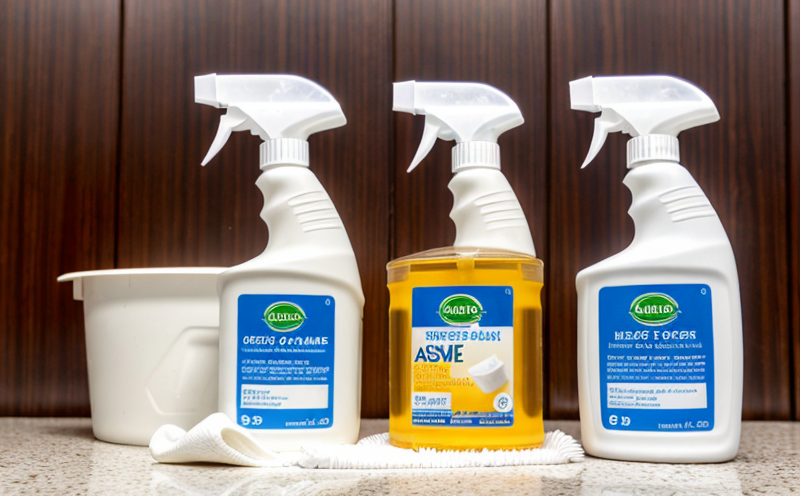ISO 17425 Odor Control Testing of Cleaning Products
The ISO 17425 standard provides a framework for odor control testing in cleaning products. This service ensures that the chemical composition and formulation of cleaning agents meet stringent standards, thereby guaranteeing their safety and effectiveness while addressing olfactory concerns.
Odor is not just about pleasant scents; it plays a crucial role in consumer perception and product acceptance. The ISO 17425 standard focuses on ensuring that the odors emitted by cleaning products are within acceptable limits as defined by regulatory bodies. This service involves rigorous testing to ensure compliance with international standards, thereby enhancing customer satisfaction and trust.
The process begins with a thorough analysis of the chemical composition of the cleaning product. This includes identifying potential volatile organic compounds (VOCs) that could contribute to off-odors or unpleasant scents. Once identified, these components undergo extensive testing using various analytical techniques such as gas chromatography-mass spectrometry (GC-MS) and sensory evaluation.
During the testing phase, samples are exposed under controlled conditions to simulate real-world usage scenarios. This allows us to assess how different factors like temperature, humidity, and storage duration affect the product's odor profile over time. The results from these tests provide valuable insights into any potential issues that may arise during production or after-market use.
Following successful completion of initial testing, our experts conduct sensory evaluations involving trained panelists who evaluate both the intended fragrance as well as any unintended odors present in the product. These panels adhere strictly to ISO guidelines ensuring consistency and accuracy across multiple batches tested simultaneously.
The final step involves generating detailed reports summarizing all findings from each phase of testing conducted. These comprehensive documents serve several purposes including providing evidence for regulatory compliance, supporting marketing claims made about our clients’ products regarding their cleanliness attributes and odour characteristics; they also help guide continuous improvement efforts within the R&D department.
By adhering to this stringent process based on ISO 17425 requirements, we ensure that every product leaving our facilities meets not only regulatory expectations but also exceeds customer expectations. This commitment translates directly into improved brand reputation and enhanced market share for our clients.
- Gas Chromatography-Mass Spectrometry (GC-MS)
- Sensory Evaluation Panels
- Regulatory Compliance Reporting
- Continuous Improvement Support
Why It Matters
The importance of odor control testing cannot be overstated in the context of cleaning and hygiene products. Unpleasant odors can significantly impact consumer perception, leading to reduced sales and negative brand associations. By ensuring that our clients' products meet rigorous standards set forth by ISO 17425, we help them maintain a competitive edge in an increasingly demanding market.
Moreover, odor control testing is essential for maintaining compliance with various regulations governing the formulation of cleaning agents. Non-compliance can result in legal actions against manufacturers and distributors, causing reputational damage and financial losses. Our services mitigate these risks by providing accurate data that supports adherence to relevant laws and guidelines.
In addition to regulatory considerations, odor control testing also contributes to improving product performance. By identifying any volatile organic compounds (VOCs) responsible for undesirable odors early on in the development process, companies can make necessary adjustments to formulations before large-scale production begins. This proactive approach not only enhances product quality but also reduces waste associated with rework or recall campaigns.
Lastly, odor control testing plays a vital role in protecting end-users' health and safety. Many cleaning products contain harsh chemicals that could potentially emit strong odors if improperly managed during manufacturing or storage processes. By conducting thorough tests according to ISO 17425 guidelines, we ensure that these risks are minimized, creating safer environments for consumers.
Quality and Reliability Assurance
Our commitment to quality is reflected in the robust systems we have implemented across all stages of odor control testing. From sample preparation through final reporting, each step adheres meticulously to ISO 17425 requirements ensuring reliability and consistency.
- Sample Preparation: Samples are prepared according to strict protocols that maintain their integrity throughout the testing process.
- Sensory Evaluation: Trained panels conduct rigorous evaluations using standardized methods, providing objective assessments of odor characteristics.
- Data Analysis: Advanced analytical techniques like GC-MS are employed to quantify VOC concentrations accurately and reliably.
- Reporting: Comprehensive reports are generated detailing all aspects of the testing process along with recommendations for improvement where needed.
The use of such advanced technologies ensures that our clients receive precise, actionable insights into their products' odor profiles. This level of detail allows them to make informed decisions about product modifications or enhancements aimed at enhancing overall consumer satisfaction and meeting regulatory requirements more effectively.
Customer Impact and Satisfaction
The success of any cleaning product lies in its ability to deliver on promises made by manufacturers. With our ISO 17425 odor control testing services, we ensure that these products not only perform well but also meet high standards for odor management.
For quality managers and compliance officers, this service offers peace of mind knowing that their products are fully compliant with all necessary regulations. They can rest assured that any potential issues related to odors have been identified early in the production cycle, allowing them to address these concerns promptly.
R&D engineers benefit greatly from our services as they gain valuable feedback on product performance during development stages. This input helps guide further refinement of formulas, ensuring that final products meet both functional and sensory expectations set by consumers.
For procurement teams involved in sourcing raw materials or evaluating new suppliers, this service provides a reliable source of information regarding the odor characteristics of various ingredients used in cleaning formulations. This knowledge enables them to select suppliers who consistently produce high-quality materials meeting strict odor control criteria.
In essence, our ISO 17425 odor control testing services play an integral role in driving customer satisfaction and loyalty by delivering products that not only work effectively but also smell good—a critical factor influencing overall user experience.





